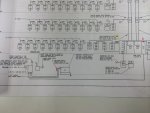Transportation Guy
Senior Member
- Location
- Williamsburg,VA
We are retrofitting an existing office building into a multi family dwelling unit. To accomplish the power, we are installing 4000 amp switchgear, and 2 runs of 1600 amp bus duct running verticle up the 7 floors. Where the bus duct comes through the floors, the GC is building per the architects drawings, a "closet" to house the bus duct, bus plug, and panel that supplies all the feeders to the individual unit panels in each apartment. The "closets" are tiny and only provide 30" of clearance between the front of the panel and the door of this closet. The engineers intent is to leave the door open so you are standing in the doorway while servicing this panel and still meet the requirement of the code. Thoughts?


